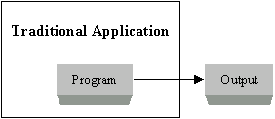|
||||||
|
Application Layer (HTTP, FTP, SMTP, TELNET, ----) |
|
Transport Layer ( TCP, UDP, ----) |
|
Internet Layer (IP, -----) |
|
Network Interface or Host-to-network Layer (device driver, ---) |
Each layer insulates the layers above it from some details of network communication. The combination of all layers is referred to as a protocol stack. Now let(s) examine each of these layers:
 Network Interface Layer
Network Interface Layer
This layer handles the lowest-level details of communication across the network. The host has to connect to the network using some protocol so that it can send IP packets over it.
 Internet Layer
Internet Layer
The Internet Layer is responsible for transmitting packets around the network. In case where packets arrive in a different order than they were sent, it is the job of higher layers to rearrange them. The Internet layer uses a protocol called IP. The job of Internet layer is to build a packet that conforms to the standard IP protocol.
 Transport Layer
Transport Layer
The layer above the Internet layer is Transport layer. It allows entities to carry on conversation. TCP is a reliable, connection-oriented protocol that guarantees the arrival of network packets. A connection must be established between the two hosts before any data is sent via TCP. The second protocol in this layer is UDP (User Datagram Protocol). It is an unreliable, connectionless protocol. No connection is established between the source and destination when a packet is sent. UDP is suitable for transmitting audio or video.
 Application Layer
Application Layer
On top of the transport layer is the application layer. The application layer is responsible for providing services particular to an application. It contains all the higher level protocols (e.g., FTP, HTTP, SMTP, TELNET, POP3, NNTP, etc.).
 Network Programming
Network Programming
The most of the programmers consider network programming to be error prone and complex because they have to know many details about the network and sometimes even the hardware. One of the biggest benefits of using Java is that it makes writing network programs very easy.
 Distributed system
Distributed system
An application whose processing is distributed across multiple networked computers is a distributed system. A distributed application is divided into parts called components or objects.
 Figure 1.3
Figure 1.3

 Figure 1.4
Figure 1.4
